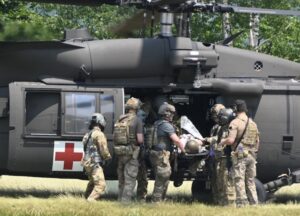
Story by Spc. Jessica Barb
Joint Force Headquarters – Pennsylvania National Guard
FORT INDIANTOWN GAP, Pa. — Medics from the Pennsylvania Army and Air National Guard trained together recently to simulate a real-life medical emergency while in the field.
Over 30 medics from the 628th Aviation Support Battalion, 28th Expeditionary Combat Aviation Brigade and the 193rd Special Operations Wing trained to become proficient in their medical tasks June 18.
Known as Operation Guardian Angel, the exercise began in the field, where two dummies were used to simulate real life casualties. They both had specific injuries that needed to be identified and have immediate attention.
The dummies were secured by the combat medics and relocated to a safe zone where medics ran through the proper safety procedures. Once the simulated casualties were stabilized, the medics called for a MEDEVAC, and a UH-60 Black Hawk helicopter arrived to take the dummies to a military hospital for additional treatment.
To have the training simulate a real-life situation, the Black Hawk flew around the surrounding area to learn how to communicate its estimated time of arrival. Once the helicopters landed, the dummies were loaded and transported to the medical station.
This was where the 193rd SOW Airmen took over to share their knowledge on efficiency and care taking of the injured patient. It was also an opportunity for the combat medics to apply their learning to see how well they could deal with stress.
Sgt. 1st Class Ashley Unger, a combat medic instructor for the 166th Regiment – Regional Training Institute, explained the importance of the exercise.
“This training allows combat medics to hone and develop their medical skills when providing treatment to casualties,” Unger said. “It provides the combat medics with a baseline on what they need to sustain and improve on. Without this training, combat medics could potentially make life-threatening mistakes to casualties on the battlefield where mistakes can’t happen.”
Unger also discussed the benefits of having Airmen from the193rd Special Operations Wing training with the Army medics.
“The training demonstrations from the 193rd SOW allowed the medics to understand how they can better treat and prepare a casualty for the next echelon of care,” Unger said. “With this knowledge, the medics can focus on what medical interventions are more beneficial to set the casualty up for success at the next echelon of care.”
The Soldiers and Airmen went through their specific checklist, and their goal was to get the patient stable and keep them stable within minutes. They lined up each casualty on a cot and would check their vitals, pulse, blood pressure and heart rate.
Master Sgt. Daniel Famous, attached to Headquarters and Headquarters Co., 28th ECAB, was at the scene with the lower enlisted as they were conducting their procedures on the patients in the field.
“I feel that the training greatly benefitted the soldiers and gave them a glimpse of what it takes to treat a real-world casualty,” Famous said. “It helped to reenforce the medical knowledge they already have and point out some areas that they need to improve on. Most of the National Guard medics don’t get a change to be put under this level of stress training. It was a real eye opener for the lower enlisted that have never deployed. The training was well executed, and it is always great to work with other units.”
The 193rd Special Operations Wing’s mission during this training was to teach the Army medics how to properly conduct a medical emergency and potentially save lives, while being under high stress.